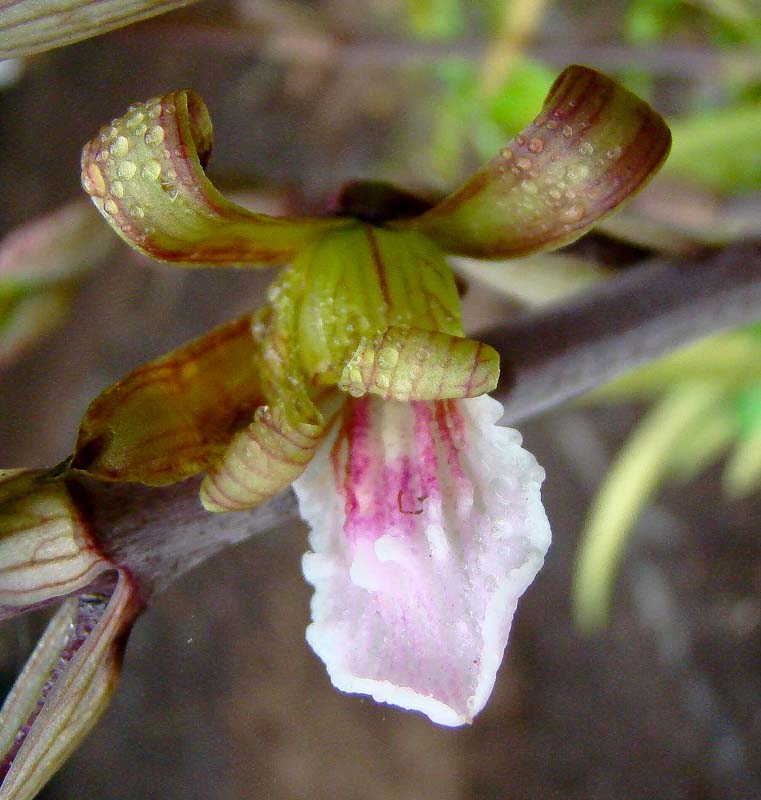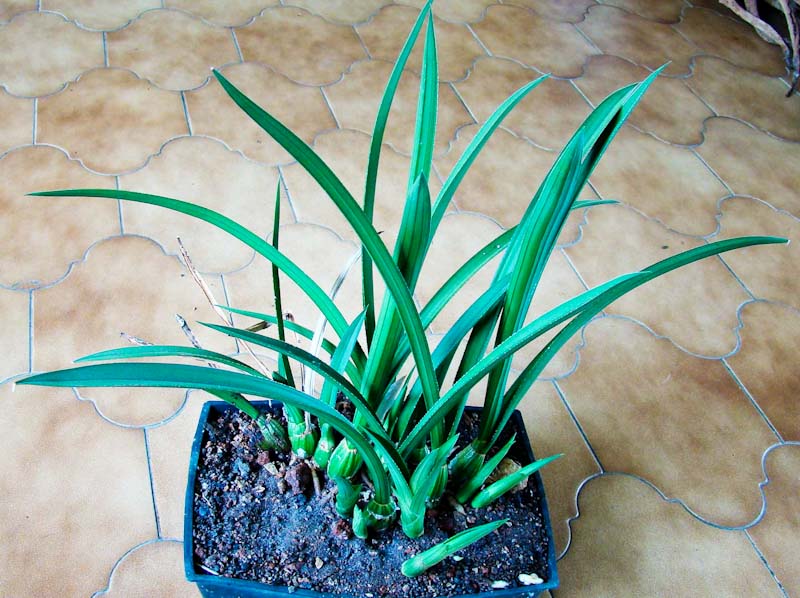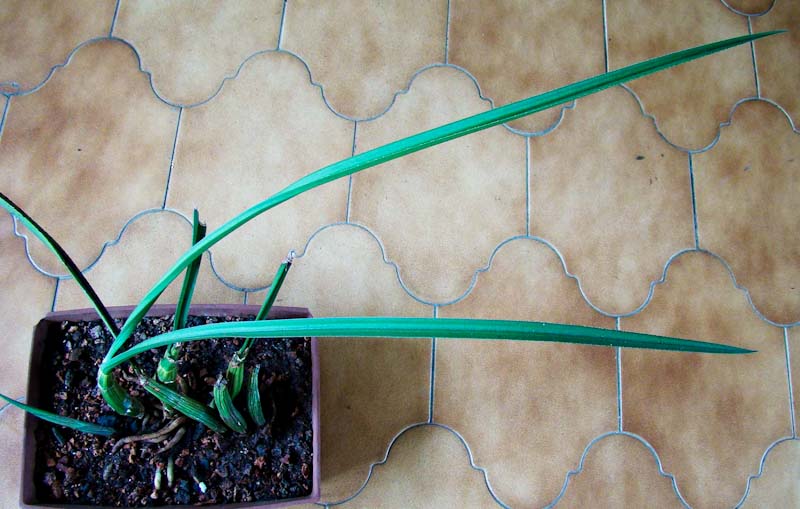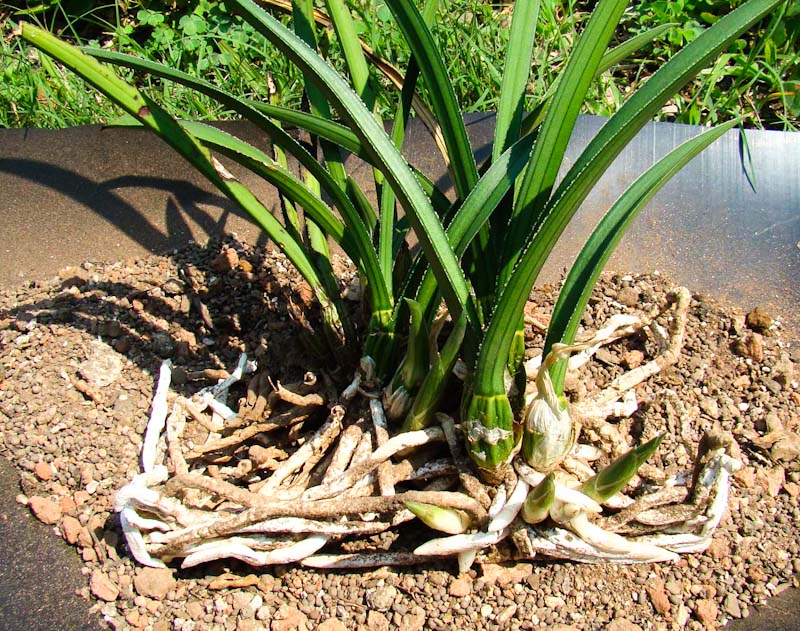Eulophia petersii

Flower of Eulophia petersii
Eulophia
petersii
The Zulu name
for this orchid is isaha
Eulophia
petersii is a terrestrial orchid belonging to plant family
Orchidaceae found growing in
thickets in hot dry arid, to very arid environments from
the
Arabian peninsular in the north down the eastern coast of Africa
southwards as
far as the Limpopo, Mpumalanga and KwaZulu-Natal provinces of South
Africa.
Eulophia
petersii is an unusual member of the orchid family in that it lives in
a harsh
environment where it has adapted to growing in very arid environments.
It is
among the
few orchid species to have
evolved a truly desert living
species.
It is often
found growing in acidic sandy soils or on rock outcroppings in
acid soil
derived from decaying granite.
Eulophia
petersii has many growth forms even within plant populations growing in
close proximity to one
another.
The leaves of Eulophia petersii are thick, fleshy and very fibrous and have a sharp serrated edge that vary considerably in length from short and broad to very long and narrow.
There are usually two to five leaves per pseudobulb.

The pseudobulbs are green to yellowish with pronounced ribbing being almost smooth when fully engorged with water and highly ribbed when very dry the vary in length considerably.

north of Durban with extremely long leaves and long thin pseudobulbs
The form that grows in Yemen on the southern tip of the Arabian peninsular is much smaller and more compact in habit.
The numerous flowers are widely spaced on a branched inflorescence that can be up to over 2 meters in length. The flowers are green with reddish brown markings with a wrinkled white lip with pink markings. There is quite a bit of variability in the colouration of flowers between plants. Often the sepals and petals are circinate, that is spirally coiled with the tip innermost as in the photo above.

Eulophia petersii plants consist of clusters of squat, fat green to yellowish stems called pseudo bulbs connected by short rhizomes that bear a small number of succulent, sharp-edged leaves. The plants are evergreen and the leaves can persist for several years, but the actual growth of the plants is highly seasonal.
New pseudobulbs and foliage are produced in spring and summer followed by tall racemes of flowers which are produced in mid-summer.
In the winter, the plants go dormant and can withstand long periods without water.
Traditional uses
Eulophia petersii is used as a love charm
Growing Eulophia petersii
Eulophia petersii are very easy and rewarding plants to grow inside and outside provided one follows a few simple rules much the same as for growing succulents. They grown well as pot plants indoors given sufficient bright light. Eulophia petersii are very hardy and take very little time to care for, to produce good results making them an idea pot plant.
My own plants are grown in a mixture of coarse gravel derived from decaying granite, crushed brick, and clean river sand to which I add a small amount of well rotted leaf mould. They also do well in general purpose cactus and succulent mixes.
I grow a number of my plants on a windowsill indoors where they get plenty of sun. Grown outdoors the yellow orchid beetle Lema pectoralis can be a major pest which can badly damage a plant in the blink of an eyelid. To control the yellow orchid beetle on my plants growing outside on my roof, at the beginning of the growing season I sprinkle Efekto insecticide granules around the plants
I do not over pot my plants but I do ensure they have enough space to develop a very good extensive root system this is essential for good results.
In summer I only water my plants when the growing medium has completely dried out for a week or so and I see that the pseudo bulbs have wilted a little. I then completely soak the plants with water in a basin to which I have added a little liquid fertilizer. Never add more fertilizer per litre than the manufacturers recommendations, this has produced very good results for me. At least once a year in the summer I take the plants outdoors and soak them heavily with a hose pipe to flush any accumulated salts out of the growing medium. This can also be done indoors in a bathtub or basin.
In winter I keep my Eulophia petersii very dry, I only water them when I see that the pseudobulbs have shrunk considerably and the two halves of the leaves have started to fold together and then only enough to slightly wet the growing medium, after a day or two I add a little more water until the pseudobulbs have regained not more than 50% of their full size. This ensures that the plants develop a very large and healthy root system as can be see in the accompanying photograph. I do not soak the plants in winter.
In the spring when new growths appear I slowly increase the amount of water given until the new pseudobulbs are well developed
Eulophia petersii do not do at all if well if they over watered in particular in winter and do not develop and maintain a good root system. The easiest way to check if your plant is being over watered or not is to gently tip it out of its growing container and to inspect the roots. A healthy well cared for plant will have an abundance healthy white roots with white tips while in active growth with no black marks or rot on them.
Eulophia petersii can be grown outside in the garden if grown in well drained soil and if they can be protected from mole rats and the yellow orchid beetle. When grown outdoors they must be grown in a hot sunny position or the new growths will tend to rot in the rainy season in places such as Durban and the Natal coast.
Eulophia petersii has all the attributes to be an excellent green roof plant, to confirm this I have tested Eulophia petersii for five years under the conditions I experience at Mount Moreland with very good results.
Eulophia petersii can easily be propagated by subdivision, which is probably best done at the end of winter when the first new growth is noticed, just be careful not to damage the new growth.
Eulophia petersii plants set seed if pollinated, but as with most other orchids the seeds can mostly only successful be grown in flasks on a special growing medium under sterile conditions. This b eing said they do grow in soil under ideal conditions as in nature.
I have never tried growing Eulophia petersii seeds in soil as I have successfully done with Eulophia speciosa, but with a little experimenting under the correct conditions it is no doubt possible.
I feed my plants once per week at very low concentrations usually one half or less than the recommended application rate with a variety of feeds, being EasyGro™ Flower and Fruit 3:1:6(46) hydroponic feed distributed by Rolfes Agri, Seagro, Nitrosol, fulvic acid as well as with both black as well as rooibos tea.
| Home |
Contact | |
| Green Roof |
Rehabilitation |
|
| Landscaping |
Weed |
|
 |
 |